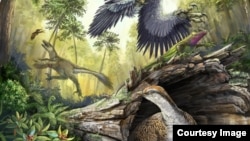Seeds may have played a role in the survival of the bird's ancestors following a meteor strike that spawned ecological changes leading to the extinction of many dinosaurs, according to a new study.
Writing in the journal Current Biology, researchers say that following the massive meteor impact which is thought to have sped up the extinction of the giant reptiles, bird-like dinosaurs with beaks but no teeth were able to survive because they could eat seeds and other food sources. Their toothed, meat-eating counterparts were more likely to die off.
"The small bird-like dinosaurs in the Cretaceous [period], the maniraptoran dinosaurs, are not a well-understood group," said first author Derek Larson, a paleontologist at the Philip J. Currie Dinosaur Museum in Alberta, Canada. "They're some of the closest relatives to modern birds, and at the end of the Cretaceous, many went extinct, including the toothed birds -- but modern crown-group birds managed to survive the extinction. The question is, why did that difference occur when these groups were so similar?"
To reach their conclusions, the researchers studied more than 3,000 fossilized teeth from the bird-like maniraptoran dinosaurs. They determined that teeth diversity indicated that these maniraptorans had “a rich and stable ecosystem over millions of years” and then were “abruptly killed off by an event at the end of the Cretaceous.”
"The maniraptoran dinosaurs maintained a very steady level of variation through the last 18 million years of the Cretaceous," said Larson. "They abruptly became extinct just at the boundary."
Separately, the lineage of dinosaurs that produced today’s birds appears to have survived because of their diet. This led to the notion that the “last common ancestor of today's birds was a toothless seed eater with a beak.”
Beaks, the researchers think, would have allowed the creatures to eat seeds, because vegetation was likely impeded from growth in the aftermath of the meteor collision.
